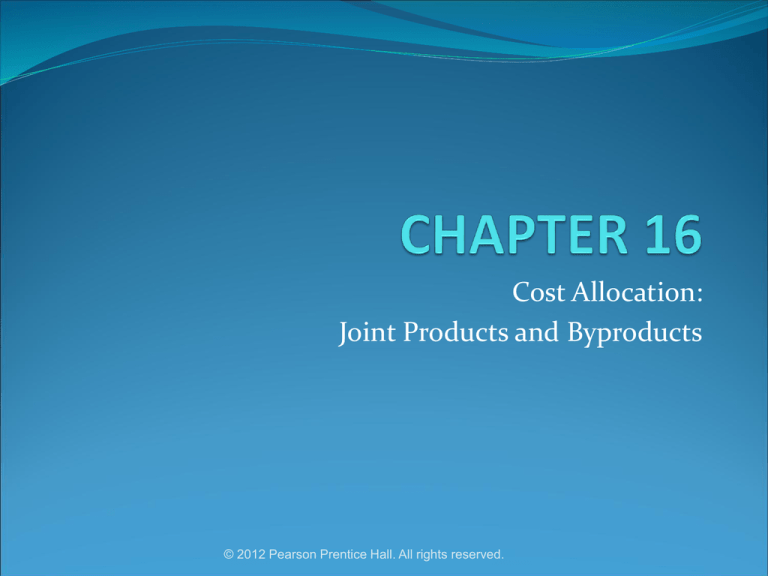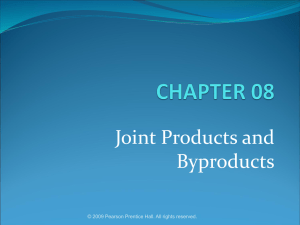
Cost Allocation:
Joint Products and Byproducts
© 2012 Pearson Prentice Hall. All rights reserved.
Joint Cost Terminology
Joint costs—costs of a single production process that
yields multiple products simultaneously
Splitoff point—the place in a joint production
process where two or more products become
separately identifiable
Separable costs—all costs incurred beyond the
splitoff point that are assignable to each of the nowidentifiable specific products
© 2012 Pearson Prentice Hall. All rights reserved.
Joint Cost Terminology
Categories of joint process outputs:
Outputs with a positive sales value
2. Outputs with a zero sales value
1.
Product—any output with a positive sales value, or
an output that enables a firm to avoid incurring
costs
Value can be high or low
© 2012 Pearson Prentice Hall. All rights reserved.
Joint Cost Terminology
Main product—output of a joint production process
that yields one product with a high sales value
compared to the sales values of the other outputs
Joint products—outputs of a joint production process
that yields two or more products with a high sales
value compared to the sales values of any other
outputs
© 2012 Pearson Prentice Hall. All rights reserved.
Joint Cost Terminology
Byproducts—outputs of a joint production process
that have low sales values compare to the sales values
of the other outputs
© 2012 Pearson Prentice Hall. All rights reserved.
Examples of Joint Cost Situations
© 2012 Pearson Prentice Hall. All rights reserved.
Joint Process Overview
Steam:
An Output with Zero Sales Value
Joint Product #1
Single Production
Process
Joint Product #2
Byproduct
© 2012 Pearson Prentice Hall. All rights reserved.
Reasons for Allocating Joint Costs
Required for GAAP and taxation purposes
Computation of inventoriable costs and cost of goods
sold for financial accounting and tax reporting
Internal analysis of divisional profitability
Cost-based contracting
Insurance settlements
Required for rate and price regulations
Litigation
© 2012 Pearson Prentice Hall. All rights reserved.
Joint Cost Allocation Methods
Market-based—allocate using market-derived data
(dollars):
Sales value at splitoff
2. Net realizable value (NRV)
3. Constant gross-margin percentage NRV
1.
Physical measures—allocate using tangible
attributes of the products, such as pounds, gallons,
barrels, and so on
© 2012 Pearson Prentice Hall. All rights reserved.
Sales Value at Splitoff Method
Uses the sales value of the entire production of the
accounting period to calculate allocation percentage
Ignores inventories
© 2012 Pearson Prentice Hall. All rights reserved.
Joint Cost Illustration Data
© 2012 Pearson Prentice Hall. All rights reserved.
Joint Cost Illustration Overview
© 2012 Pearson Prentice Hall. All rights reserved.
Sales Value at Splitoff Illustration
© 2012 Pearson Prentice Hall. All rights reserved.
Net Realizable Value Method
Allocates joint costs to joint products on the basis of
relative NRV of total production of the joint products
NRV = Final Sales Value – Separable Costs
© 2012 Pearson Prentice Hall. All rights reserved.
Net Realizable Value Method
Overview
© 2012 Pearson Prentice Hall. All rights reserved.
Net Realizable Value Method
Illustrated
© 2012 Pearson Prentice Hall. All rights reserved.
Net Realizable Value Method
Illustrated
© 2012 Pearson Prentice Hall. All rights reserved.
Constant Gross Margin NRV Method
Allocates joint costs to joint products in a way that the
overall gross-margin percentage is identical for the
individual products.
Joint costs are calculated as a residual amount.
© 2012 Pearson Prentice Hall. All rights reserved.
Constant Gross Margin NRV Illustrated
© 2012 Pearson Prentice Hall. All rights reserved.
Physical-Measure Method
Allocates joint costs to joint products on the basis of
the relative weight, volume, or other physical measure
at the splitoff point of total production of the products
© 2012 Pearson Prentice Hall. All rights reserved.
Physical Measures Illustration
© 2012 Pearson Prentice Hall. All rights reserved.
Method Selection
If selling price at splitoff is available, use the sales
value at splitoff method.
If selling price at splitoff is not available, use the
NRV method.
If simplicity is the primary consideration, physicalmeasures method or the constant gross-margin
method could be used.
Despite this, some firms choose not to allocate joint
costs at all.
© 2012 Pearson Prentice Hall. All rights reserved.
Sell-or-Process Further Decisions
In sell-or-process further decisions, joint costs are
irrelevant. Joint products have been produced, and a
prospective decision must be made: to sell
immediately or process further and sell later.
Joint costs are sunk costs.
Don’t assume all separable costs in joint-cost
allocations are always incremental costs.
Some separable costs may be fixed costs.
Separable costs need to be evaluated for relevance
individually .
© 2012 Pearson Prentice Hall. All rights reserved.
Sell-or-Process Further Flowchart
Final
Product
#1
Joint Product #1
Further Processing Dept 1
Single Production
Process
Final
Product
#2
Joint Product #2
Further Processing Dept 2
© 2012 Pearson Prentice Hall. All rights reserved.
Byproducts
Two methods for accounting for byproducts
Production method—recognizes byproduct inventory
as it is created, and sales and costs at the time of sale
Sales method—recognizes no byproduct inventory,
and recognizes only sales at the time of sales:
byproduct costs are not tracked separately
© 2012 Pearson Prentice Hall. All rights reserved.
Byproducts Illustration Overview
© 2012 Pearson Prentice Hall. All rights reserved.
Comparative Income Statements for
Accounting for Byproducts
© 2012 Pearson Prentice Hall. All rights reserved.
© 2012 Pearson Prentice Hall. All rights reserved.







